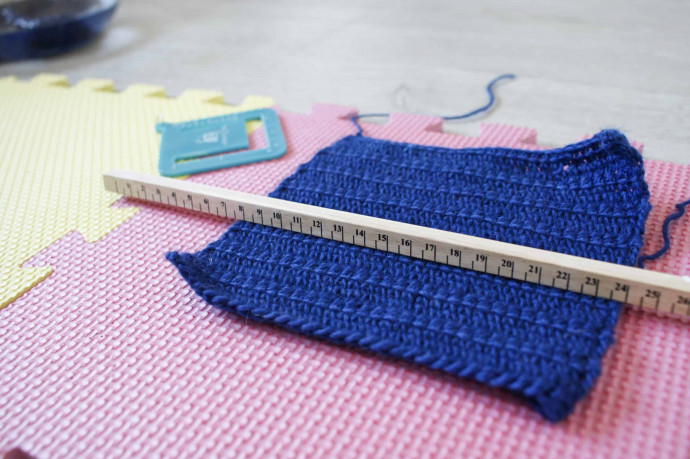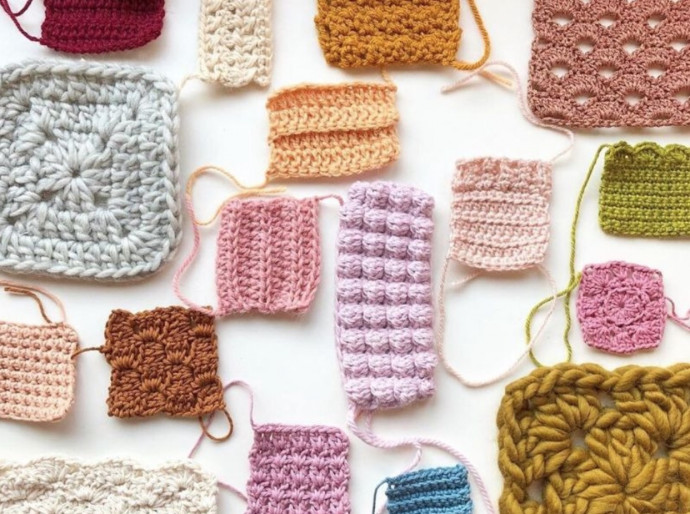Gauge is known as tension, a term that accurately reflects many crocheters’ thoughts on the subject! Gauge is simply a description of how many stitches and rows a particular crocheted (or knitted) fabric has within a certain area. Gauge is nothing to be afraid of, however, and it’s important, so let’s take a moment to understand the concept of gauge and how to get it.
1. What determines gauge?

Gauge is dependent on a number of factors, including hook size, yarn size, your individual way of handling hook and yarn, and even your mood at a particular moment!
2. How is gauge stated?

Gauge may be expressed in stitches and rows per inch (or centimeter), or in stitches and rows per 4" (10 cm), with a suggested hook size. Sometimes the row gauge is omitted.
For example: 12 stitches and 15 rows = 4" (10 cm) in single crochet with J/10 (6.0 mm) hook
A gauge may also be stated in terms of number of pattern repeats or complete rounds of a motif.
For example: Two pattern repeats = 7" with H/8 (5.0 mm) hook
or
Rounds 1–3 of granny square = 3" with H/8 (5.0 mm) hook
3. Should I always use the hook size that is given in the pattern?

No, but it’s a good starting point. It is the size the designer used to get the stated gauge with the yarn used in the project, but every individual’s handling of yarns and hooks varies. Even when using identical hooks and yarns, two crocheters can get very different gauges. If you need to change hook size to obtain a stated gauge, please do so. That does not mean that you are right and the gauge statement is wrong but just illustrates the fact that gauge is achieved in a wide variety of ways.
4. How do I figure out what my gauge is?

You’ll need to make and measure a gauge swatch: a small piece of fabric made using the same yarn, hook, and stitch pattern you plan to use for your project.
5. How big should my gauge swatch be?

Ideally, a swatch should be no less than 4" across; 6" or more is better. The thicker the yarn, the bigger the swatch you need. The finest thread crochet swatches can be somewhat smaller. If you are working a stitch pattern with multiples, you’ll need to make the swatch big enough to encompass at least one multiple.
6. How do I measure stitch gauge?

Place the swatch flat on a table. (Voice of Experience: Do use a flat surface, not your leg or the sofa cushion, as these surfaces aren’t really flat.) Place a ruler on top of the swatch. (A ruler is preferable to a tape measure because it lies flat and doesn’t stretch.) Measuring from the 1" mark, count the number of stitches to the 5" (that is 4" worth of stitches). Don’t count the outer stitch or two on either edge and don’t measure the first two rows or the last row, as these edge stitches are often uneven or distorted. If you don’t have 4" worth of stitches, use what you have. The more stitches you can count over a longer distance, the more accurate your results will be. Divide the number of stitches by the number of inches for your gauge per inch.
7. How do I make a gauge swatch?

Start with enough chains to make an adequately sized swatch, taking care to work the chain loosely. Be sure to adjust the number of stitches to fit any stitch pattern multiples. Begin stitching, using the stitch pattern given in the gauge statement and the same hook and yarn you plan to use for the project. Different hooks, even those of the same size, handle yarn differently. Even different colors of the same yarn may work up to different gauges! Because the same yarn in different colors can yield different gauges, use all the colors in the same way you plan to use them in the finished product, if you are using more than one color.
Work in the same way the project requires (in the round or back and forth), unless otherwise stated in the pattern. Crochet at least 2", then measure to see if you are anywhere close to the desired gauge. If not, stop stitching. Start a new swatch from the beginning with a different size hook. If you are close, continue stitching until your piece is about 6" long.
8. What if I have a partial stitch at the 4" mark?

Since it’s hard to estimate what fraction of stitch hits right at that mark, it is more accurate to count full stitches within a certain distance. Keep counting full stitches until you reach a spot that corresponds to an easy-to-read measurement on your ruler. Make a note of what distance those stitches cover, then use that number as your divisor.
For example: If you count 19 full stitches over 41⁄4"
19 ÷ 4.25 = 4.47 sts per inch, or 17.88 sts = 4
9. My stitch pattern makes it difficult to count individual stitches. How can I measure stitch gauge?

Identify each stitch repeat in your stitch pattern. These are often a combination of stitches that are visible as a distinct unit. Count the number of pattern repeats within 4-plus inches, then multiply the number of pattern repeats by the number of stitches in each repeat and divide that by the distance over which you measured.
For example: If you count three full stitch pattern repeats over 51⁄2", and each pattern repeat has nine stitches, (3 repeats × 9 sts per repeat) ÷ 5.5 = 4.9 sts per inch, or 19.64 sts = 4”
The technique is the same as for row gauge, but place the ruler vertically rather than horizontally on the swatch.










